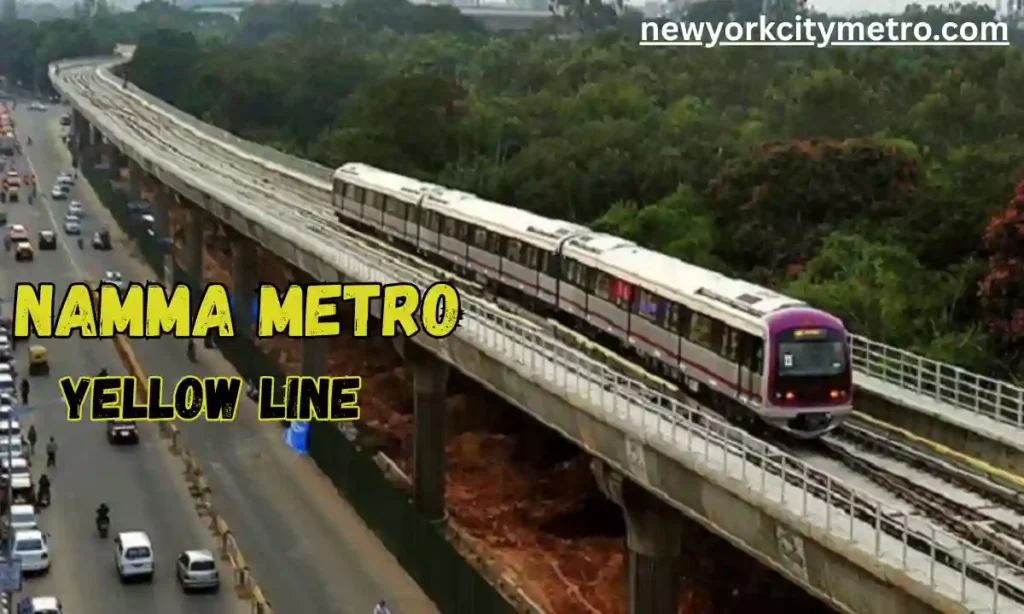Bengaluru’s expanding network of metro is expecting the launch of Namma Metro Yellow Line in July/August 2025. This upcoming corridor is designed RV Road to Bommasandra through various bustling areas. It connects the Southern and Southeastern areas of Bengaluru and reduces traffic on roads. The line also enhances the efficiency of metro network by providing the interchanges between different metro lines.
Launch Status
The Namma Metro yellow line is yet to be launched. The structure of the station is fully complete and all the stations that are covered in the route of 18.8 km are ready for operations. But, commercial services are delayed because of trainset shortages. It is said that this metro line will be launched for partial operations in June 2025. However, the full launch is expected to happen between July-August, most probably in August 2025.
Routes and Stations
This metro line covers the route of total 18.8 km connecting the Southern and Southeastern parts of Bengaluru. The line connects Rashtreeya Vidyalaya Road to Delta Electronics – Bommasandra. In between these two, it covers 16 stations. The route is strategically designed to connect all the regions – industrial, IT hubs as well as residential areas between Southern and Southeastern Bengaluru. These stations are:
- Rashtreeya Vidyalaya Road (R.V. Road)
- Ragigudda
- Jayadeva Hospital
- BTM Layout
- Central Silk Board
- Bommanahalli (RoopenaAgrahara)
- Hongasandra (GarvebhaviPalya)
- Kudlu Gate
- Singasandra
- Hosa Road
- BeratenaAgrahara
- KonappanaAgrahara (Infosys Foundation KonappanaAgrahara)
- Electronic City
- Husker Road (Veersandra/ Huskuru Road)
- Hebbagodi (BioconHebbagodi)
- Delta Electronics – Bommasandra (terminal)
Interchange Stations
It has three interchange points that seamlessly connects this metro line to other lines in the network. It ensures efficient connectivity and travel.
- Rashtreeya Vidyalaya Road (R.V. Road) –it interchanges with the green line of Bengaluru metro network that connects Nagasandra to Silk Institute Line. This interchange is a connection between southern parts to northern regions.
- Jayadeva Hospital –it interchanges with the pink line that connects Gottigere to Nagawara Line.
- Central Silk Board –it interchanges with the Blue line that connects Central Silk Board to Kempegowda International Airport Line. This interchange features direct connectivity to the airport.
Also Read About: Andrew Schulz – The King of Crowd Work
Operational Aspects
The yellow line in Bengaluru metro network is all set to operate from 5am to 11pm. However, timings may vary on weekends and holidays.
The frequency of the trains will be around 5 minutes in peak hours. In off-peak hours, trains will be slower by around 10 minutes. Notably, during the initial operations, shortage of trains will likely lead to trains running at a frequency of about 20 minutes. This line will be fully reliable for daily travel until the completion of CMRS certification.
Details about Fares
Fares range from ₹10 to ₹60. It will charge based on the distance travelled. For example, ₹10 will be charged for upto 2 km and so on. Passengers who use smart-card enjoy additional discounts. For example, they get 5% discount in the travel charges. Also, if they travel in off-peak hours, they enjoy an additional 5% off.
Features of Namma Metro Yellow Line

There are various features of this yet-to-launch metro line in Bengaluru that helps in improving the travel and connectivity. These fine features are:
- Modern Designs – The stations that are covered in this route are all designed with modern strategies. Facilities like escalators, elevators and more and available along with special amenities for disabled people.
- Saves Energy – The trains of yellow line are made to save energy. These trains have regenerative braking system that makes them energy efficient.
- Safety – The stations and trains are equipped with CCTV surveillance that ensures the safety of passengers.
- Connectivity – the interchanges improves cross-city travel by reducing the need to face heavy on-road traffic.
- Fully Elevated – the route this line covers is 18.8 km long and is fully elevated that helps avoiding travel issues and saves times.
- CBTC System –the trains use Communication Based Train Control. It means that it has a semiautomated driverless system. This feature helps in saving time as it reduces the delays and ensures timely intervals.
- Integration of Technology – The metro line provides real-time tracking through the mobile app. Passengers can also purchase tickets through the app. Additionally, the line also provides free wifi at some stations.
Challenges Faced during Development
During the construction and development of the line, various challenges were faced.
- During Covid 19, construction faces various setbacks like delays, shortage of labours, disruptions in supply chain and more.
- The construction of the like took so long and it disrupted the road travel as the construction led to the closures of roads. Areas like Hosur Road, Silk Board faced major problems of heavy traffic.
- Shortage of trainset. As of mid 2025, only one is available for initial operations.
- The coordination between safety agencies, contractors and BMRCL has been slow. Hence, faced delays.
- The progress was also affected due to the delays in funding and approvals.
- Repeated pushed timelines have frustrated the planning authorities as all as passengers.
Also Read About: Claire Most Journey From Finance to Fashion


